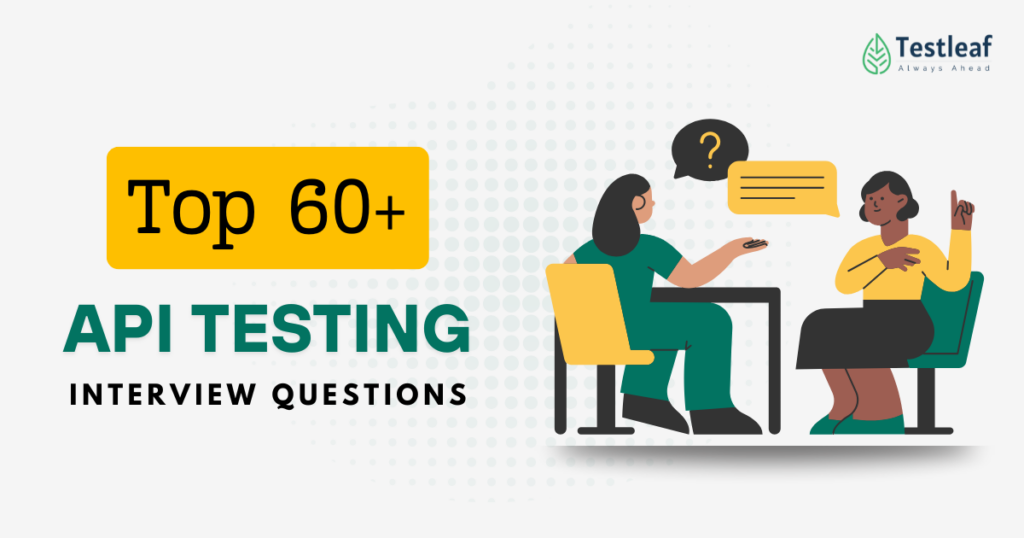Introduction
APIs (Application Programming Interfaces) are the backbone of modern software development, enabling seamless communication between different applications and services. As a fresher in the field of software testing or development, understanding API testing is crucial for ensuring software quality, efficiency, and security. This document provides key API interview questions along with concise answers to help you prepare for job interviews and enhance your technical knowledge.
For Fresher’s:
-
What is API testing, and why is it important?
- API testing is a type of software testing that focuses on verifying the functionality, performance, security, and reliability of APIs. It ensures that APIs return the correct responses, handle different inputs correctly, and interact seamlessly with other systems. Since APIs are the backbone of modern applications, ensuring their accuracy is critical to avoid failures in communication between services.
-
What are the differences between API testing and UI testing?
- API testing focuses on validating the business logic, data exchange, and interactions between different system components at the API level, without involving a graphical user interface.
- UI testing, on the other hand, verifies the appearance, usability, and overall functionality of an application’s graphical interface from an end-user perspective.
- API testing is faster and more reliable for backend validation, whereas UI testing often takes longer and is more prone to visual inconsistencies.
-
Explain the components of an API request.
- An API request consists of several components:
- Endpoint (URL): The address where the API can be accessed.
- Method: The HTTP method that specifies the action (e.g., GET, POST, PUT, DELETE).
- Headers: Metadata included in the request, such as content type, authentication details, and cache control.
- Body: The payload containing data (in JSON, XML, etc.) sent with requests like POST and PUT.
- Query Parameters: Additional parameters passed in the URL (e.g., ?id=123).
- An API request consists of several components:
-
What are HTTP methods? Name a few commonly used ones.
- HTTP methods define the type of action performed on a resource. Common HTTP methods include:
- GET: Retrieves data from a server.
- POST: Sends data to the server to create a resource.
- PUT: Updates an existing resource.
- DELETE: Removes a resource.
- PATCH: Partially updates a resource.
- HEAD: Retrieves response headers without the response body.
- HTTP methods define the type of action performed on a resource. Common HTTP methods include:
-
What is the difference between SOAP and REST APIs?
- SOAP (Simple Object Access Protocol):
- A protocol-based approach with strict standards.
- Uses XML format for request and response.
- Built-in security and error handling.
- Requires more bandwidth due to XML verbosity.
- REST (Representational State Transfer):
- Architectural style that uses HTTP methods.
- Supports multiple formats like JSON, XML, HTML.
- Lightweight and widely used due to simplicity.
- Preferred for web and mobile applications.
- SOAP (Simple Object Access Protocol):
-
What is the purpose of status codes in API responses?
- HTTP status codes indicate the outcome of an API request. Common codes include:
- 200 OK: Successful request.
- 201 Created: A new resource has been created.
- 400 Bad Request: The request was malformed or contained invalid data.
- 401 Unauthorized: Authentication is required but missing or incorrect.
- 403 Forbidden: Access is denied due to permissions.
- 404 Not Found: The requested resource does not exist.
- 500 Internal Server Error: A generic error occurred on the server.
- HTTP status codes indicate the outcome of an API request. Common codes include:
-
Can you explain the difference between POST , PUT and PATCH methods?
-
-
POST → Used to create a new resource. Every time you send a POST request, a new resource is created with a unique ID. It does not update existing data.
-
PUT → Used to update an existing resource. It replaces the entire resource’s data with the new data provided in the request body. 🔹 Example: Updating a user’s profile with new details (name, email, etc.).
- PATCH → Used to partially update an existing resource. Instead of replacing the entire resource like PUT, PATCH only updates the specific fields provided in the request body. 🔹 Example: Updating just the user’s phone number without changing other details.
-
-
-
What tools are commonly used for API testing?
- Common tools include:
- Postman: A user-friendly tool for API testing and automation.
- RestAssured: A Java library for API automation.
- SoapUI: Primarily used for SOAP API testing but also supports REST.
- JMeter: Used for performance testing of APIs.
- WireMock: Used for API mocking.
- Common tools include:
-
How do you validate API responses?
- API responses can be validated by:
- Checking the status code.
- Validating the response body against expected values.
- Ensuring the correct headers are returned.
- Measuring response time.
- API responses can be validated by:
-
What is JSON and XML? Which one is preferred in REST APIs?
- JSON (JavaScript Object Notation): Lightweight, easy to read and write, widely used in REST APIs.
- XML (Extensible Markup Language): More structured but heavier than JSON.
- Preferred: JSON is preferred due to its simplicity and efficiency.
-
What are headers in API requests, and why are they used?
- Headers provide metadata such as content type (application/json), authentication tokens, and cache settings.
-
How do you handle authentication in API testing?
- Authentication mechanisms include:
- Basic Authentication: Username and password encoded in base64.
- OAuth: Token-based authentication.
- API Keys: Unique keys provided in headers.
- JWT (JSON Web Tokens): A secure, stateless authentication method.
- Authentication mechanisms include:
-
What is an endpoint in an API?
- An endpoint is a specific URL where an API service is exposed (e.g., https://api.example.com/users).
-
What is API mocking, and why is it needed?
- API mocking simulates responses to test applications when the actual API is unavailable or in development.
-
What are query parameters and path parameters?
- Query Parameters → These are key-value pairs added to the URL after a ? symbol. They are mainly used for filtering, searching, or sorting data.
🔹 Example: https://example.com/users?name=John&age=25 - Path Parameters → These are part of the URL structure itself and are used to identify a specific resource.
🔹 Example: https://example.com/users/123 - Query Parameters → Used for filtering or modifying responses.
- Path Parameters → Used to access a specific resource.
- Query Parameters → These are key-value pairs added to the URL after a ? symbol. They are mainly used for filtering, searching, or sorting data.
-
What is the difference between 401 and 403 status codes?
- 401 Unauthorized: The request is missing authentication credentials or has invalid ones.
- 403 Forbidden: The user does not have permission to access the resource.
-
How do you test negative scenarios in API testing?
- Sending invalid data, incorrect headers, or unauthorized requests.
-
What is rate limiting in APIs?
- Rate limiting controls the number of API requests a user can make within a timeframe to prevent abuse.
- Example: A weather API allows only 50 requests per hour for free users. If a user exceeds this, they must wait or upgrade to a paid plan.
-
How do you handle dynamic values in API testing?
- Use parameterization and correlation to replace dynamic values like timestamps and unique IDs.
-
What is an API contract?
-
- An API contract defines the structure, request parameters, and expected responses of an API. It acts as a blueprint for development and testing.
Additional Resources: EPAM Interview Questions with Answers
Intermediate-level API testing interview questions:
-
Explain the differences between functional and non-functional API testing.
- Functional API Testing: Focuses on verifying the correctness of the API’s functionality. It ensures that the API behaves as expected based on the requirements. Examples include testing endpoints, request/response validation, error handling, and business logic.
- Non-Functional API Testing: Focuses on aspects like performance, reliability, scalability, and security. Examples include load testing, stress testing, security testing, and latency measurement.
-
What are the best practices for API test automation?
- Use a robust framework (e.g., Postman, RestAssured, or pytest).
- Write reusable and modular test scripts.
- Validate response status codes, headers, and payloads.
- Use data-driven testing for multiple scenarios.
- Implement proper error handling and logging.
- Integrate tests into CI/CD pipelines for continuous testing.
- Mock dependencies for isolated testing.
- Follow version control for test scripts.
-
How do you test API performance?
- Use tools like JMeter, Gatling, or LoadRunner.
- Test for response time, throughput, and latency under various loads.
- Conduct stress testing to determine breaking points.
- Monitor server resources (CPU, memory) during testing.
- Validate performance against SLAs (Service Level Agreements).
-
What is the role of API documentation in testing?
- API documentation (e.g., Swagger/OpenAPI) serves as a reference for understanding endpoints, request/response formats, and authentication methods.
- It helps testers design accurate test cases and validate API behavior.
- Automated tests can be generated directly from documentation.
-
How do you handle API versioning?
- Use URL-based versioning (e.g., /v1/resource).
- Implement header-based versioning (e.g., Accept: application/vnd.api.v1+json).
- Ensure backward compatibility for older versions.
- Clearly document version changes and deprecation policies.
-
What is an idempotent method in API testing?
- An idempotent method produces the same result regardless of how many times it is executed. For example, GET, PUT, and DELETE are idempotent, while POST is not.
- Testing idempotency involves sending the same request multiple times and verifying the response and server state.
-
How do you manage API test data?
- Use test data management tools or databases.
- Create isolated test environments to avoid conflicts.
- Use data seeding scripts to populate test data.
- Clean up test data after execution to maintain consistency.
-
Explain the concept of pagination in APIs.
- Pagination is used to split large datasets into smaller chunks (pages) for efficient retrieval.
- Common methods include offset-based pagination (?page=1&limit=10) and cursor-based pagination (?cursor=abc123).
- Test pagination by verifying the correct number of items per page and the ability to navigate between pages.
-
What is a WebSocket, and how does it differ from REST APIs?
- WebSocket: A bidirectional communication protocol that allows real-time data exchange between client and server.
- REST API: A stateless, request-response protocol over HTTP.
- WebSocket is ideal for real-time applications (e.g., chat apps), while REST is better for CRUD operations.
-
What is OAuth, and how does it work?
- OAuth is an authorization framework that allows third-party applications to access user data without sharing credentials.
- It involves tokens (access and refresh tokens) and flows like Authorization Code, Implicit, and Client Credentials.
- Test OAuth by validating token generation, expiration, and scopes.
-
How do you perform security testing for APIs?
- Test for authentication and authorization mechanisms.
- Validate input to prevent SQL injection, XSS, and other attacks.
- Use tools like OWASP ZAP or Burp Suite.
- Check for sensitive data exposure in responses.
- Test rate limiting and DDoS protection.
-
What is HATEOAS in RESTful services?
- HATEOAS (Hypermedia as the Engine of Application State) is a constraint in RESTful APIs where responses include hyperlinks to related resources.
- It enables clients to navigate the API dynamically without prior knowledge of endpoints.
- Test HATEOAS by verifying the presence and correctness of hyperlinks in responses.
-
How do you handle API chaining in testing?
- API chaining involves using the output of one API as the input for another.
- Store responses in variables and pass them to subsequent requests.
- Use tools like Postman or scripts to automate chaining.
- Validate the final output after the chain completes.
-
What is the difference between GraphQL and REST?
- REST: Uses fixed endpoints and returns predefined data structures.
- GraphQL: Allows clients to query specific data fields and relationships in a single request.
- GraphQL is more flexible but requires careful schema design.
-
How do you test APIs in a CI/CD pipeline?
- Integrate API tests into CI/CD tools like Jenkins, GitLab, or CircleCI.
- Use automated test frameworks to run tests on every build.
- Fail the pipeline if tests do not pass.
- Generate and publish test reports for visibility.
-
What is schema validation in API testing?
- Schema validation ensures that API responses adhere to a predefined structure (e.g., JSON schema).
- Tools like JSON Schema Validator or libraries in Python/Java can be used.
- It helps catch structural errors in responses.
-
How do you handle session management in APIs?
- Use tokens (e.g., JWT) for stateless session management.
- Validate token expiration and renewal mechanisms.
- Test for session hijacking and token leakage.
-
Explain the use of response time validation in API testing.
- Response time validation ensures that APIs meet performance benchmarks.
- Measure and compare response times against SLAs.
- Use tools like Postman or JMeter to monitor and report response times.
-
What are webhooks, and how are they tested?
- Webhooks are user-defined HTTP callbacks triggered by events.
- Test webhooks by simulating events and verifying that the correct payload is sent to the endpoint.
- Use tools like ngrok to expose local endpoints for testing.
-
How do you perform contract testing in APIs?
- Contract testing ensures that the API implementation matches the agreed-upon contract (e.g., OpenAPI specification).
- Use tools like Pact or Dredd to validate requests and responses against the contract.
- Focus on backward compatibility and adherence to schema.
You Might Also Like: Hexaware Java Interview Questions and Answers 2025: Top FAQs to Crack Your Interview
Experience- Interview Questions:
-
How do you optimize API test execution time?
- Parallel Execution: Run tests in parallel using tools like Postman Collections, RestAssured, or pytest-xdist.
- Selective Testing: Prioritize critical test cases and avoid redundant tests.
- Mocking: Use tools like WireMock or MockServer to simulate dependencies and reduce execution time.
- Data Management: Use efficient data setup and teardown methods to avoid delays.
- Caching: Cache responses for repeated requests to avoid redundant calls.
-
What challenges have you faced in API testing, and how did you overcome them?
- Challenge 1: Handling dynamic data (e.g., timestamps, tokens).
- Solution: Use parameterization and correlation to manage dynamic values.
- Challenge 2: Testing APIs with dependencies on third-party services.
- Solution: Use service virtualization or mocking.
- Challenge 3: Flaky tests due to network issues or server instability.
- Solution: Implement retry mechanisms and robust error handling.
- Challenge 4: Testing APIs with complex authentication mechanisms.
- Solution: Use tools like Postman or RestAssured to automate token generation and validation.
-
How do you design a scalable API test framework?
- Modularity: Create reusable components for requests, validations, and utilities.
- Data-Driven Testing: Use external data sources (e.g., CSV, Excel) to run tests with multiple datasets.
- Configuration Management: Use configuration files to manage environments, endpoints, and credentials.
- Integration with CI/CD: Integrate the framework with CI/CD tools like Jenkins or GitLab for continuous testing.
- Reporting: Implement detailed reporting using tools like Allure or Extent Reports.
-
What are microservices, and how do they impact API testing?
- Microservices: A software architecture where applications are built as a collection of small, independent services.
- Impact on API Testing:
- Increased complexity due to multiple services and dependencies.
- Requires testing of individual services (unit testing) and their interactions (integration testing).
- Emphasizes the need for contract testing to ensure compatibility between services.
-
How do you handle API dependencies in testing?
- Mocking: Use tools like WireMock or MockServer to simulate dependent services.
- Service Virtualization: Create virtualized environments for dependencies.
- Stubs: Use stubs to mimic the behavior of dependent APIs.
- Contract Testing: Ensure APIs adhere to agreed-upon contracts to avoid dependency issues.
-
What is service virtualization, and how does it help in API testing?
- Service Virtualization: Simulating the behavior of dependent services that are unavailable or in development.
- Benefits:
- Enables testing without relying on real services.
- Reduces testing bottlenecks and delays.
- Allows testing of edge cases and error scenarios.
-
How do you test API throttling and rate limiting?
- Throttling: Test by sending multiple requests within a short timeframe and verifying the API enforces limits.
- Rate Limiting: Validate that the API blocks requests exceeding the allowed rate.
- Tools: Use JMeter or Gatling to simulate high traffic and monitor responses.
-
Explain circuit breaker patterns in API testing.
- Circuit Breaker Pattern: A design pattern that prevents cascading failures by stopping requests to a failing service.
- Testing:
- Simulate service failures and verify the circuit breaker trips.
- Test recovery by restoring the service and verifying normal operation.
-
How do you test APIs for backward compatibility?
- Versioning: Test older API versions to ensure they still work.
- Contract Testing: Validate that new changes do not break existing contracts.
- Regression Testing: Run regression tests to ensure new updates do not affect existing functionality.
-
What strategies do you use to test APIs in a distributed environment?
- Service Virtualization: Simulate services in a distributed system.
- Contract Testing: Ensure compatibility between services.
- Load Testing: Test the system under high traffic to identify bottlenecks.
- Monitoring: Use tools like Prometheus or Grafana to monitor performance.
-
How do you integrate API testing with DevOps?
- CI/CD Integration: Integrate API tests into CI/CD pipelines using tools like Jenkins or GitLab.
- Automation: Automate API tests to run on every build.
- Reporting: Generate test reports and notify teams of failures.
- Infrastructure as Code: Use tools like Terraform to manage test environments.
-
What is gRPC, and how is it tested?
- gRPC: A high-performance RPC framework using HTTP/2 and Protocol Buffers.
- Testing:
- Use tools like BloomRPC or Postman for manual testing.
- Automate tests using libraries like grpcurl or frameworks like pytest.
-
How do you perform contract-based testing using Pact?
- Pact: A tool for contract testing between consumers and providers.
- Steps:
- Define contracts in the consumer tests.
- Verify contracts in the provider tests.
- Ensure both sides adhere to the agreed-upon contract.
-
Explain how to handle flaky API tests in automation.
- Retry Mechanisms: Implement retries for transient failures.
- Stabilize Environment: Ensure test environments are stable and consistent.
- Isolate Tests: Run tests in isolation to avoid interference.
- Monitor and Debug: Use logs and reports to identify and fix flaky tests.
-
How do you handle API failures in a production environment?
- Monitoring: Use tools like New Relic or Datadog to detect failures.
- Alerting: Set up alerts for critical failures.
- Rollback: Revert to a stable version if necessary.
- Root Cause Analysis: Investigate and fix the underlying issue.
-
How do you perform penetration testing for APIs?
- Tools: Use tools like OWASP ZAP or Burp Suite.
- Test Cases: Test for vulnerabilities like SQL injection, XSS, and broken authentication.
- Authorization: Validate access controls and permissions.
- Reporting: Document findings and recommend fixes.
-
What are the differences between API Gateway and Load Balancer?
- API Gateway: Manages API traffic, enforces policies, and provides routing, security, and monitoring.
- Load Balancer: Distributes incoming traffic across multiple servers to ensure high availability and reliability.
-
How do you test asynchronous APIs?
- Polling: Continuously check for a response until it’s available.
- Webhooks: Test by simulating callback URLs and verifying payloads.
- Tools: Use tools like Postman or RestAssured with polling mechanisms.
-
What are the key metrics for API performance testing?
- Response Time: Time taken to receive a response.
- Throughput: Number of requests handled per second.
- Error Rate: Percentage of failed requests.
- Latency: Time taken for a request to travel from client to server and back.
- CPU/Memory Usage: Server resource utilization during testing.
-
Explain how AI/ML is impacting API testing.
Artificial Intelligence (AI) and Machine Learning (ML) are revolutionizing API testing by enhancing automation, efficiency, and accuracy. Some key impacts include:
- Test Case Generation: AI-powered tools can analyze system behavior and automatically generate optimized API test cases, reducing manual effort.
- Intelligent Test Execution: ML algorithms can predict which test cases are most likely to fail based on historical data, prioritizing critical tests.
- Anomaly Detection: AI can identify abnormal API behavior, such as performance degradation or security vulnerabilities, by continuously monitoring test results.
- Self-Healing Tests: AI-driven frameworks can automatically update test scripts when API endpoints or parameters change, reducing maintenance efforts.
- Performance Optimization: AI analyzes API performance metrics to detect bottlenecks and suggest improvements.
By integrating AI/ML into API testing, organizations can achieve faster, smarter, and more reliable testing processes.
Conclusion
API testing is an essential skill for software testers and developers. Understanding how APIs work, their different components, and how to test them efficiently can improve software quality and reliability. By mastering API concepts and using the right tools, freshers can enhance their career prospects in the software industry. Enrolling in a Rest API online training program can further strengthen your knowledge and practical skills. Preparing for these interview questions will help you confidently tackle API-related discussions in job interviews and real-world projects.
We Also Provide Training In:
- Advanced Selenium Training
- Playwright Training
- Gen AI Training
- AWS Training
- REST API Training
- Full Stack Training
- Appium Training
- DevOps Training
- JMeter Performance Training
Author’s Bio:

As CEO of TestLeaf, I’m dedicated to transforming software testing by empowering individuals with real-world skills and advanced technology. With 24+ years in software engineering, I lead our mission to shape local talent into global software professionals. Join us in redefining the future of test engineering and making a lasting impact in the tech world.
Babu Manickam
CEO – Testleaf






